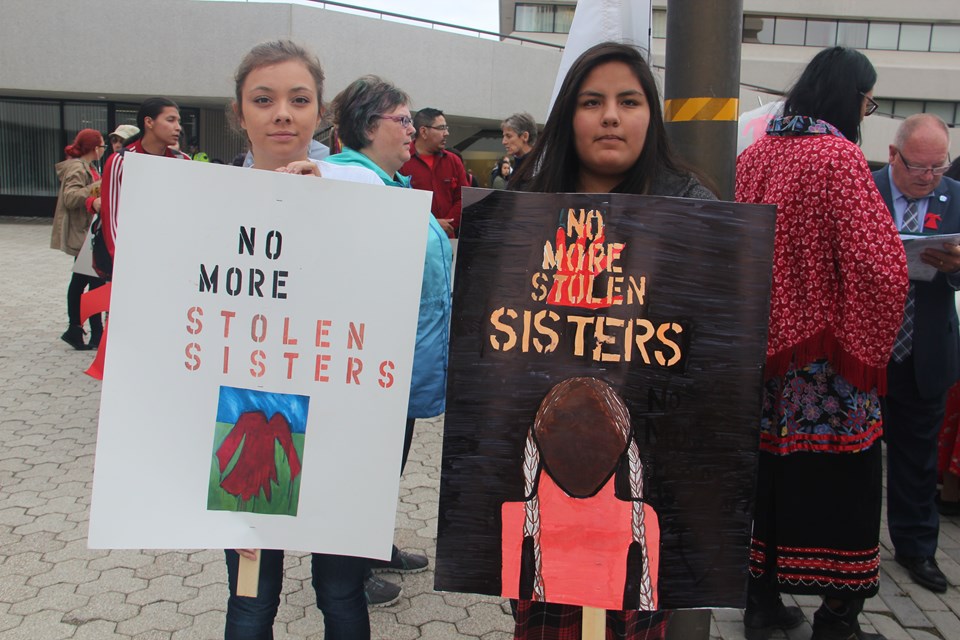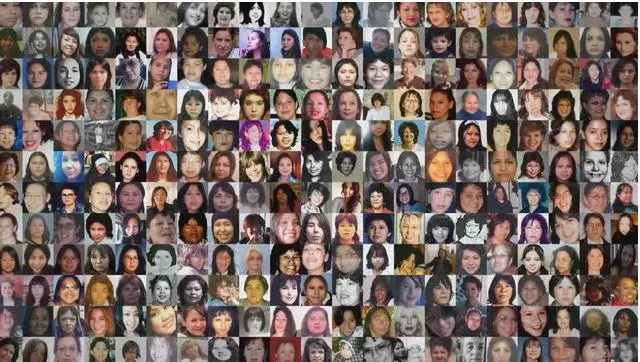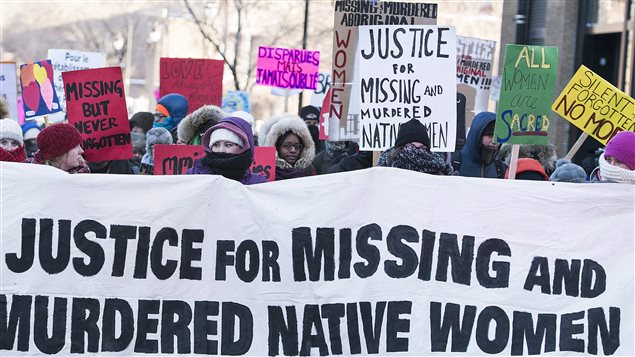Missing and Murdered Indigenous Women and Girls, Trans and 2 Spirited People (MMIWGT2S): Voice of a Family Member
Early days, no one including Indigenous people believed there was a crisis happening within the borders of our country called Canada within your very own community.
The first memorial march was held over 25 years ago in Vancouver’s Downtown Eastside also known at DTES. The march was led by Indigenous women and other community members in response to the murder of a Coast Salish woman. Indigenous women have continued to bring people together to remember lost loved ones and have mobilized to stop the violence or to slow it down.
This led to a number of awareness campaigns to bring attention to the crisis of MMIWGT2S. However, for a long time, the general population ignored their voices and the yearly marches.
It wasn’t until 2004 that mass attention was brought to the issue when Amnesty International partnered with the Native Women’s Association of Canada (NWAC) to produce the report, Stolen Sisters.
The Stolen Sisters documented 500 cases of MMIWT2S in the Stolen Sisters report. The report focused on 9 cases. It documented the reality that Indigenous women and girls face heighted threats of violence And Indigenous women are specifically targeted for acts of extreme violence and brutality including domestic assaults.
One example documented in the Stolen Sisters report is the killing of Helen Betty Osborne. Helen Betty Osborne was a 19-year old Cree student from The Pas, a Northern Manitoba town. She planned to become a teacher. She was abducted by four white men in the town of The Pas where she was sexually assaulted and murdered.
The Manitoba Justice Inquiry into the death of Helen Betty Osborne said:
“Her attackers seemed to be operating on the assumption that Aboriginal women were promiscuous and open to enticement through alcohol or violence. It is evident that the men who abducted Osborne believed that young Aboriginal women were objects with no human value beyond sexual gratification”
The inquiry also found that the investigation into her death was “sloppy” and “racially biased.” The inquiry indicated that the police had long been aware of white men sexually preying on Indigenous women but did not feel the practice warranted any particular vigilance on their part.
In the case of Pamela George’s murder, two white men were tried before a white judge and an all-white jury. The trial in the Pamela George case paid little attention to the life of Pamela George before she became a sex worker, even although the men did not attack her while she was working in the sex trade.
Nonetheless, the Judge (Justice Malone) instructed the jurors to bear in mind that Pamela “indeed was a prostitute” when they considered whether or not she had consented to sexual activity. This is an overtly abusive use of a women’s sexual history to bias the court in favour of the perpetrators. We see the continued reliance on rape myths in a number of cases before the courts today.
The perpetrators were portrayed as young men with “bright futures”. The trial solidified the fact that violence against Indigenous women in Canada is seen as natural. It also obscured the role of the Canadian state and the criminal justice system in producing and perpetuating such violence
Canadians watched as the names of missing and murdered Indigenous women continued to increase. And so, the numbers of documented MMIW continued to rise
- 500 names
- 800 names
- 2018, hundreds of names of missing and murdered Indigenous women continue to cross the media every single day crossing the threshold of 1,300 names of the missing and murdered Indigenous women and girls.
In this context, former President of the Native Women’s Association of Canada, Bev Jacobs, cries out to Canadians:
“I want them to care about what’s happening. I want them to care about the families that have been traumatized. I want them to care about why this is happening. I want them to care that this is a systemic problem and that we’re all responsible.”

In recent years, awareness of missing and murdered Indigenous women has grown. Exactly what Indigenous women have been saying for over two centuries about the violence they face and why they have been marching for over a quarter century is finally being widely articulated.
Meanwhile we’ve reached thousands of documented names of missing and murdered women – documented because many individuals have not been included; others remain missing with no investigation into their whereabouts.
In this context, Sarah Hunt indicates: “One by one, colonial logics turn our loved ones into statistics …Yet, as the numbers climb higher with each new death, will they ever be enough to compel the changes that will transform this culture of violence?”
Colonial logics, is a logic of dehumanization – of turning people into statistics - 500, 600, 800, thousand? It begins from the assumption of emptiness. This same assumption guided the doctrine of discovery, premised on the idea of terra nullius (empty land). But, as Thobani indicates, it was also premised on the idea of humanitas nullius (empty people). By dehumanizing Indigenous persons – especially Indigenous women – the land could be seen as empty of humanity.
We continue today, in many ways, to treat Indigenous women’s bodies as empty of humanity.
The Treatment of Cindy Gladue in R v Barton
Cindy Gladue was born in Athabasca on July 23, 1974; she was raised in Calling Lake and later moved to Edmonton. She was the first-born child to her mother, Donna and father, Lawrence but she was her Kokum’s girl – she loved her Grandma. Cindy had three beautiful girls who she loved more than anything. As her Mom describes her: “She was a lot like you and I. She loved life, she had a family, dreams, emotions. She was kind, caring and funny. She was a beautiful woman inside and out and she was loved deeply.”
In the trial transcripts, the members of court – including the Crown Prosecutor – refer to her as the “prostitute,” the “Native girl”, and “Native woman” throughout the trial. Cindy Gladue bled to death as a result of a wound inflicted upon her by Mr. Bradley Barton.
When the police initially told her family of her death, they reported it to them as seemingly caused by “natural causes.” Days later, to the surprise of the family, Bradley Barton was arrested for her murder. Yet, rather than delivering justice, the court responded to her assault with its own measure of violence.
The R v. Barton case was heard by Justice Rob Graesser and an 11-person jury comprised of nine men and two women – none of whom identified as being Indigenous – at the Court of Queen’s Bench of Alberta in February and March of 2015.
In an act of complete and unprecedented dehumanization, a portion of her sexual organs — human remains — were brought into the court. Arguing her pelvic tissue should be considered “real evidence” – meaning, it was seen as being relevant and material to the trial proceedings – the Crown sought to have the preserved tissue shown to the jury. These actions alongside other graphic displays of the court dehumanized Cindy Gladue and resulted in the re-victimization of her family. As Cree Metis Elder Lynda Budreau-Smaganis stated: “Her mother sat through that trial and listened to the evidence and it was really disturbing.”
Ryan Cormier, of the Edmonton Journal, documented in detail what was not shared with the court. Evidence collected from Bradley Barton’s laptop documented searches for extremely violent pornography. This was not shown to the jury. The depictions of violence in the images were consistent with the injuries that led to Cindy’s death. While excluding some evidence, the court completely disregarded the dignity and integrity of Cindy Gladue’s body, the dignity of her family, or “any indigenous perspective on caring for the dead.”
The treatment of Cindy Gladue reveals that the very system that dispossessed indigenous people from their lands is continuing to create harms through inflicting varying forms of violence. It led many indigenous people to ask, ‘how can we reconcile with a state that continues to perform violently against us? How can we reconcile with an abuser?”
National Inquiry into the Missing and Murdered Indigenous Women and Girls
What is a National Commission of Inquiry
National Commissions of Inquiry are federally established investigations into issues of national importance. Federal inquiries are established under terms set out in the Inquiries Act.
- This Act says that the federal Cabinet can establish an inquiry at any time. Cabinet also has the discretion to determine the inquiry’s subject and scope (s2 Inquiries Act).
- The Act is broad and gives the federal government plenty of discretion
- Meaning, there is a lot of room for flexibility and creativity in designing the inquiry process
- This can help to ensure that inquiry will be a meaningful and sensitive process
- But, it also means that early and thorough research and consultation is extremely important
- This is to inform the inquiry’s design so that it can facilitate and support a fair, responsive, and effective process
- This is to inform the inquiry’s design so that it can facilitate and support a fair, responsive, and effective process
BC Missing Women Inquiry
“If there were only one recommendation to come from this report, it would be that commissions of inquiry that intend to work with marginalized populations as witnesses, or inquiries that are called in response to the concerns of marginalized communities, must consult thoroughly at every stage with those communities and the organizations that work with those communities.”
The Commission of a National Inquiry has the power to determine the methods of an inquiry.
The wide discretion of the Commission with regards to designing its own process is important to keep in mind
- A Commission can use any combination of types of process, from community gatherings, to formal hearings, to invited symposia, and individual collection of stories.
- It can also design new and unique types of proceeding.
Terms Of Reference the Commissioners are directed to identify:
- systemic causes of violence — including sexual violence — against Indigenous women and girls in Canada
- identify the underlying social, economic, cultural, institutional and historical causes,”
- identify "institutional policies and practices”
- culturally sensitive and trauma-aware way
- find some way to memorialize the victims
Police and the Judicial System
A significant concern that was raised during the pre-inquiry process about what role the inquiry could or would play in inquiring into the role of the police and the judicial system.
The initial terms of reference released by the liberal government’s Minister of Indigenous and Northern Affairs (Carolyn Bennett) were very vague/quiet on this matter. There was nothing in the terms of reference of the commission explicitly referring to investigating our police and courts:
- many thought this was a diplomatic choice in order to keep the terms broad for the commission to establish its mandate
- others raised concern about whether police would be included under the commissions mandate

In response, many families raised the concern that this would miss an important part of pursuing justice for their experience and Neil Macdonald (a senior correspondent at CBC):
indicated that the epidemic of MMIW occurs in a context where police have been part of the violence towards indigenous people and where indigenous women have been disproportionately criminalized.
There are a significant number of unsolved cases and for Macdonald it means this is largely a law enforcement matter. It can also mean that it is in fact a larger societal matter only in that police forces tend to enforce the status quo which largely ignores Indigenous people and especially Indigenous women.
“Together, we form a network that is not in reference to a violent legal order, but in reference to our older relationships with the land, with the water, with the supernatural world, and with one another. We form a network of people walking in honor not only of the individual people we have lost to these interwoven violences, but also in honor of our ancestors who first fought against the onslaught of policies rooted in our dehumanization.
The depths of our remembrance resonate across this land, invigorating a deep love for our relations and calling for a better tomorrow.
…we know the numbers are far greater than we can comprehend. And we know that even one violent death is one too many.”
All my Relations,
Maggie Cywink
MMIWGT2S Voice of a Family Member
mcywink@gmail.com






